Qiankun Liu
XYZCylinder: Feedforward Reconstruction for Driving Scenes Based on A Unified Cylinder Lifting Method
Oct 09, 2025Abstract:Recently, more attention has been paid to feedforward reconstruction paradigms, which mainly learn a fixed view transformation implicitly and reconstruct the scene with a single representation. However, their generalization capability and reconstruction accuracy are still limited while reconstructing driving scenes, which results from two aspects: (1) The fixed view transformation fails when the camera configuration changes, limiting the generalization capability across different driving scenes equipped with different camera configurations. (2) The small overlapping regions between sparse views of the $360^\circ$ panorama and the complexity of driving scenes increase the learning difficulty, reducing the reconstruction accuracy. To handle these difficulties, we propose \textbf{XYZCylinder}, a feedforward model based on a unified cylinder lifting method which involves camera modeling and feature lifting. Specifically, to improve the generalization capability, we design a Unified Cylinder Camera Modeling (UCCM) strategy, which avoids the learning of viewpoint-dependent spatial correspondence and unifies different camera configurations with adjustable parameters. To improve the reconstruction accuracy, we propose a hybrid representation with several dedicated modules based on newly designed Cylinder Plane Feature Group (CPFG) to lift 2D image features to 3D space. Experimental results show that XYZCylinder achieves state-of-the-art performance under different evaluation settings, and can be generalized to other driving scenes in a zero-shot manner. Project page: \href{https://yuyuyu223.github.io/XYZCYlinder-projectpage/}{here}.
MAFE R-CNN: Selecting More Samples to Learn Category-aware Features for Small Object Detection
May 22, 2025Abstract:Small object detection in intricate environments has consistently represented a major challenge in the field of object detection. In this paper, we identify that this difficulty stems from the detectors' inability to effectively learn discriminative features for objects of small size, compounded by the complexity of selecting high-quality small object samples during training, which motivates the proposal of the Multi-Clue Assignment and Feature Enhancement R-CNN.Specifically, MAFE R-CNN integrates two pivotal components.The first is the Multi-Clue Sample Selection (MCSS) strategy, in which the Intersection over Union (IoU) distance, predicted category confidence, and ground truth region sizes are leveraged as informative clues in the sample selection process. This methodology facilitates the selection of diverse positive samples and ensures a balanced distribution of object sizes during training, thereby promoting effective model learning.The second is the Category-aware Feature Enhancement Mechanism (CFEM), where we propose a simple yet effective category-aware memory module to explore the relationships among object features. Subsequently, we enhance the object feature representation by facilitating the interaction between category-aware features and candidate box features.Comprehensive experiments conducted on the large-scale small object dataset SODA validate the effectiveness of the proposed method. The code will be made publicly available.
Multi-Object Tracking in the Dark
May 10, 2024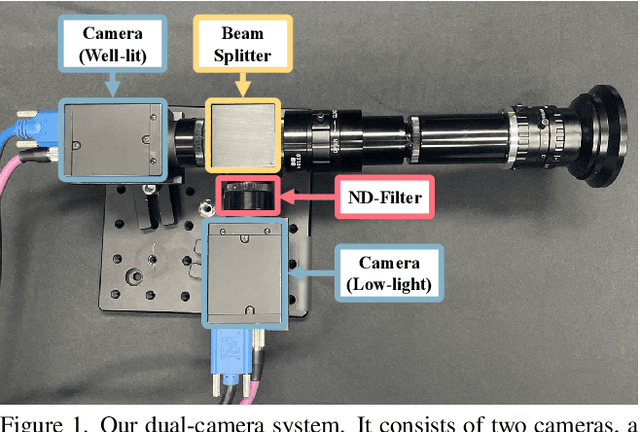
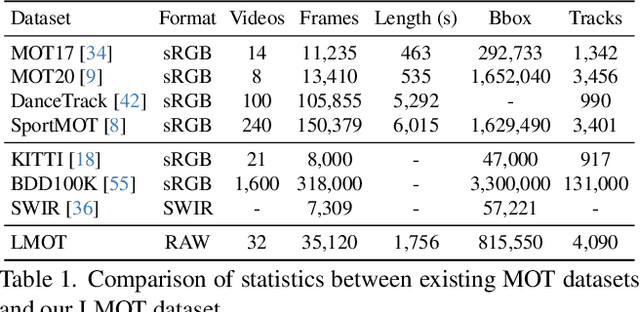


Abstract:Low-light scenes are prevalent in real-world applications (e.g. autonomous driving and surveillance at night). Recently, multi-object tracking in various practical use cases have received much attention, but multi-object tracking in dark scenes is rarely considered. In this paper, we focus on multi-object tracking in dark scenes. To address the lack of datasets, we first build a Low-light Multi-Object Tracking (LMOT) dataset. LMOT provides well-aligned low-light video pairs captured by our dual-camera system, and high-quality multi-object tracking annotations for all videos. Then, we propose a low-light multi-object tracking method, termed as LTrack. We introduce the adaptive low-pass downsample module to enhance low-frequency components of images outside the sensor noises. The degradation suppression learning strategy enables the model to learn invariant information under noise disturbance and image quality degradation. These components improve the robustness of multi-object tracking in dark scenes. We conducted a comprehensive analysis of our LMOT dataset and proposed LTrack. Experimental results demonstrate the superiority of the proposed method and its competitiveness in real night low-light scenes. Dataset and Code: https: //github.com/ying-fu/LMOT
Transformer based Pluralistic Image Completion with Reduced Information Loss
Apr 15, 2024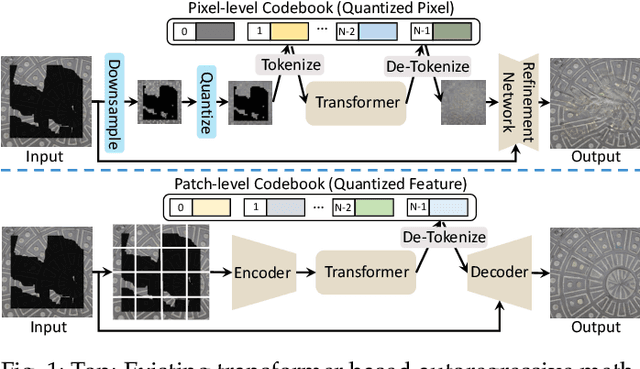


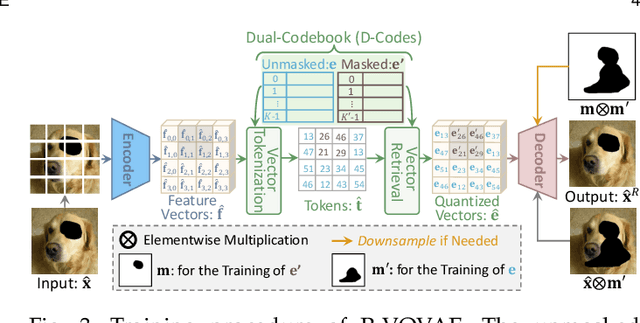
Abstract:Transformer based methods have achieved great success in image inpainting recently. However, we find that these solutions regard each pixel as a token, thus suffering from an information loss issue from two aspects: 1) They downsample the input image into much lower resolutions for efficiency consideration. 2) They quantize $256^3$ RGB values to a small number (such as 512) of quantized color values. The indices of quantized pixels are used as tokens for the inputs and prediction targets of the transformer. To mitigate these issues, we propose a new transformer based framework called "PUT". Specifically, to avoid input downsampling while maintaining computation efficiency, we design a patch-based auto-encoder P-VQVAE. The encoder converts the masked image into non-overlapped patch tokens and the decoder recovers the masked regions from the inpainted tokens while keeping the unmasked regions unchanged. To eliminate the information loss caused by input quantization, an Un-quantized Transformer is applied. It directly takes features from the P-VQVAE encoder as input without any quantization and only regards the quantized tokens as prediction targets. Furthermore, to make the inpainting process more controllable, we introduce semantic and structural conditions as extra guidance. Extensive experiments show that our method greatly outperforms existing transformer based methods on image fidelity and achieves much higher diversity and better fidelity than state-of-the-art pluralistic inpainting methods on complex large-scale datasets (e.g., ImageNet). Codes are available at https://github.com/liuqk3/PUT.
Infrared Small Target Detection with Scale and Location Sensitivity
Mar 28, 2024Abstract:Recently, infrared small target detection (IRSTD) has been dominated by deep-learning-based methods. However, these methods mainly focus on the design of complex model structures to extract discriminative features, leaving the loss functions for IRSTD under-explored. For example, the widely used Intersection over Union (IoU) and Dice losses lack sensitivity to the scales and locations of targets, limiting the detection performance of detectors. In this paper, we focus on boosting detection performance with a more effective loss but a simpler model structure. Specifically, we first propose a novel Scale and Location Sensitive (SLS) loss to handle the limitations of existing losses: 1) for scale sensitivity, we compute a weight for the IoU loss based on target scales to help the detector distinguish targets with different scales: 2) for location sensitivity, we introduce a penalty term based on the center points of targets to help the detector localize targets more precisely. Then, we design a simple Multi-Scale Head to the plain U-Net (MSHNet). By applying SLS loss to each scale of the predictions, our MSHNet outperforms existing state-of-the-art methods by a large margin. In addition, the detection performance of existing detectors can be further improved when trained with our SLS loss, demonstrating the effectiveness and generalization of our SLS loss. The code is available at https://github.com/ying-fu/MSHNet.
Towards More Unified In-context Visual Understanding
Dec 05, 2023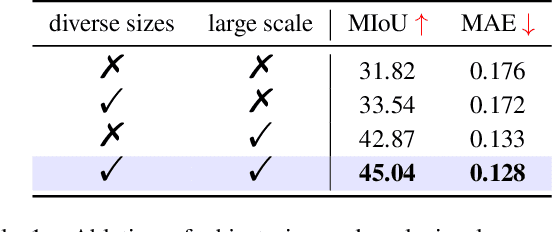
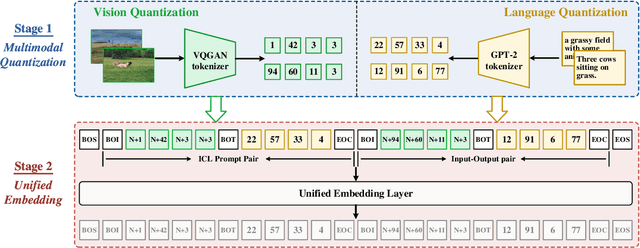
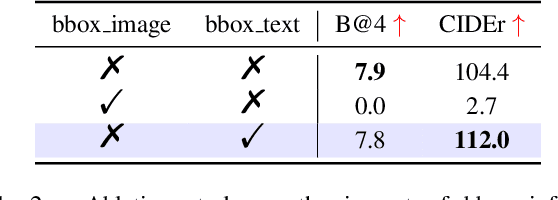
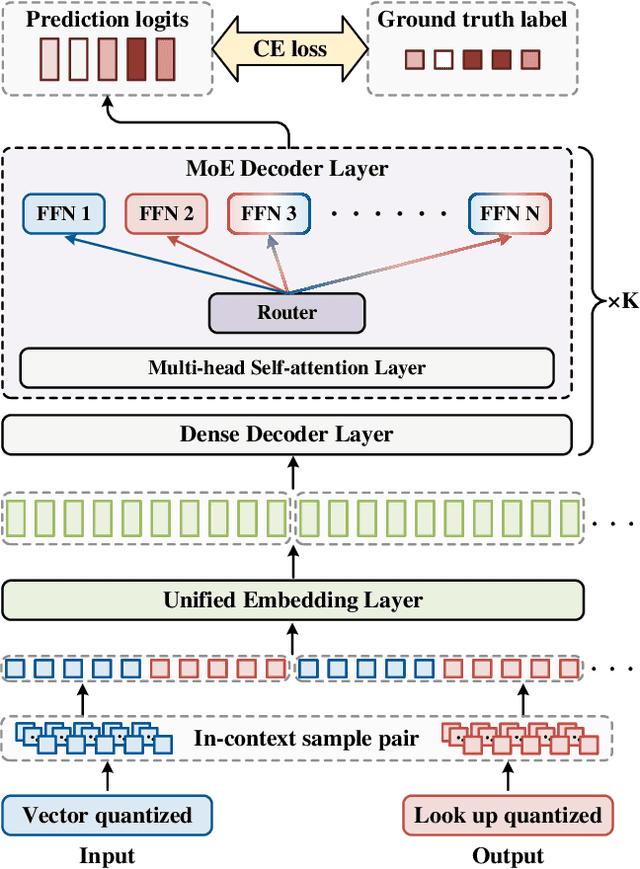
Abstract:The rapid advancement of large language models (LLMs) has accelerated the emergence of in-context learning (ICL) as a cutting-edge approach in the natural language processing domain. Recently, ICL has been employed in visual understanding tasks, such as semantic segmentation and image captioning, yielding promising results. However, existing visual ICL framework can not enable producing content across multiple modalities, which limits their potential usage scenarios. To address this issue, we present a new ICL framework for visual understanding with multi-modal output enabled. First, we quantize and embed both text and visual prompt into a unified representational space, structured as interleaved in-context sequences. Then a decoder-only sparse transformer architecture is employed to perform generative modeling on them, facilitating in-context learning. Thanks to this design, the model is capable of handling in-context vision understanding tasks with multimodal output in a unified pipeline. Experimental results demonstrate that our model achieves competitive performance compared with specialized models and previous ICL baselines. Overall, our research takes a further step toward unified multimodal in-context learning.
Siamese-DETR for Generic Multi-Object Tracking
Oct 27, 2023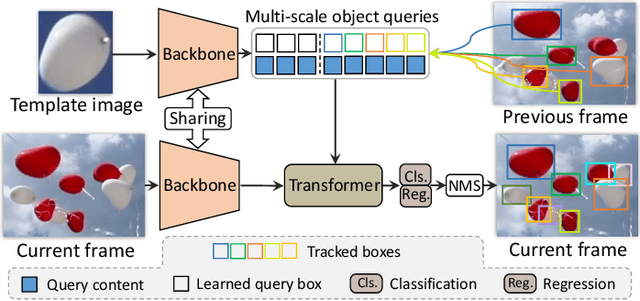
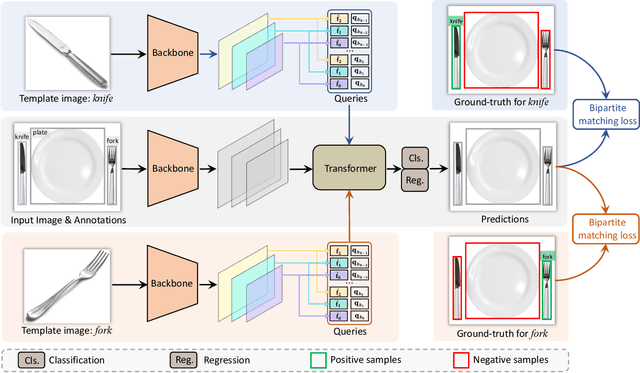
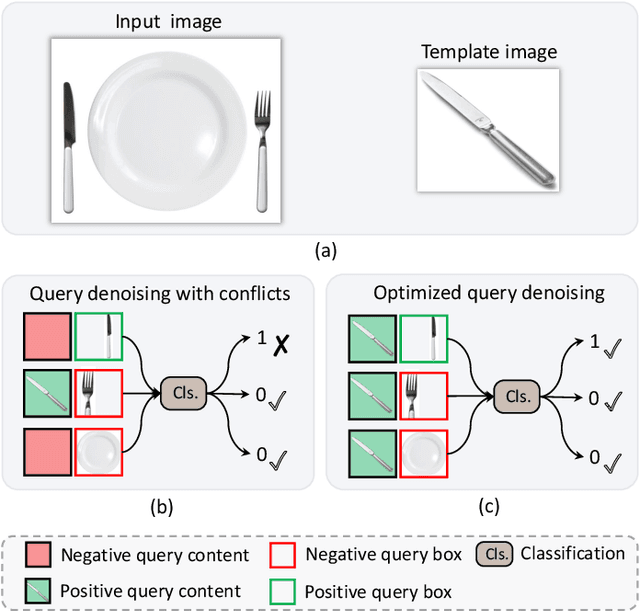
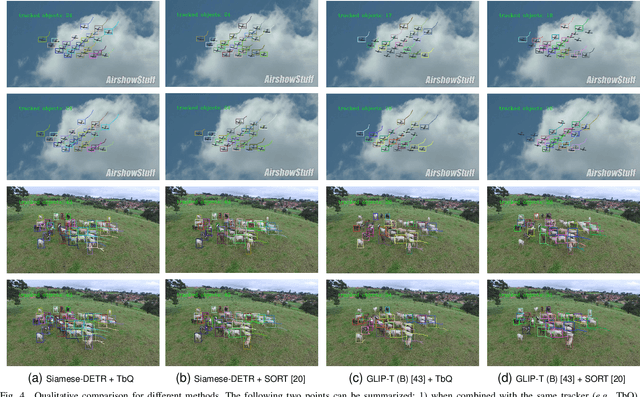
Abstract:The ability to detect and track the dynamic objects in different scenes is fundamental to real-world applications, e.g., autonomous driving and robot navigation. However, traditional Multi-Object Tracking (MOT) is limited to tracking objects belonging to the pre-defined closed-set categories. Recently, Open-Vocabulary MOT (OVMOT) and Generic MOT (GMOT) are proposed to track interested objects beyond pre-defined categories with the given text prompt and template image. However, the expensive well pre-trained (vision-)language model and fine-grained category annotations are required to train OVMOT models. In this paper, we focus on GMOT and propose a simple but effective method, Siamese-DETR, for GMOT. Only the commonly used detection datasets (e.g., COCO) are required for training. Different from existing GMOT methods, which train a Single Object Tracking (SOT) based detector to detect interested objects and then apply a data association based MOT tracker to get the trajectories, we leverage the inherent object queries in DETR variants. Specifically: 1) The multi-scale object queries are designed based on the given template image, which are effective for detecting different scales of objects with the same category as the template image; 2) A dynamic matching training strategy is introduced to train Siamese-DETR on commonly used detection datasets, which takes full advantage of provided annotations; 3) The online tracking pipeline is simplified through a tracking-by-query manner by incorporating the tracked boxes in previous frame as additional query boxes. The complex data association is replaced with the much simpler Non-Maximum Suppression (NMS). Extensive experimental results show that Siamese-DETR surpasses existing MOT methods on GMOT-40 dataset by a large margin.
Exploring the Application of Large-scale Pre-trained Models on Adverse Weather Removal
Jun 15, 2023Abstract:Image restoration under adverse weather conditions (e.g., rain, snow and haze) is a fundamental computer vision problem and has important indications for various downstream applications. Different from early methods that are specially designed for specific type of weather, most recent works tend to remove various adverse weather effects simultaneously through either spatial feature representation learning or semantic information embedding. Inspired by the various successful applications of large-scale pre-trained models (e.g, CLIP), in this paper, we explore the potential benefits of them for this task through both spatial feature representation learning and semantic information embedding aspects: 1) for spatial feature representation learning, we design a Spatially-Adaptive Residual (\textbf{SAR}) Encoder to extract degraded areas adaptively. To facilitate its training, we propose a Soft Residual Distillation (\textbf{CLIP-SRD}) strategy to transfer the spatial knowledge from CLIP between clean and adverse weather images; 2) for semantic information embedding, we propose a CLIP Weather Prior (\textbf{CWP}) embedding module to make the network handle different weather conditions adaptively. This module integrates the sample specific weather prior extracted by CLIP image encoder together with the distribution specific information learned by a set of parameters, and embeds them through a cross attention mechanism. Extensive experiments demonstrate that our proposed method can achieve state-of-the-art performance under different and challenging adverse weather conditions. Code will be made available.
HQ-50K: A Large-scale, High-quality Dataset for Image Restoration
Jun 08, 2023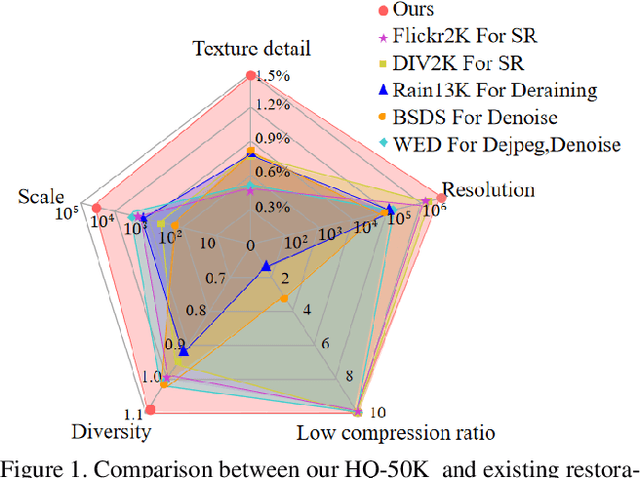


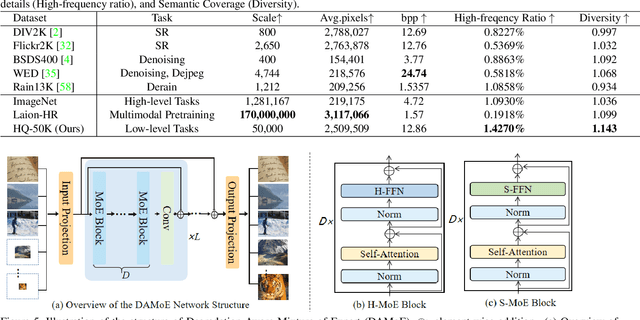
Abstract:This paper introduces a new large-scale image restoration dataset, called HQ-50K, which contains 50,000 high-quality images with rich texture details and semantic diversity. We analyze existing image restoration datasets from five different perspectives, including data scale, resolution, compression rates, texture details, and semantic coverage. However, we find that all of these datasets are deficient in some aspects. In contrast, HQ-50K considers all of these five aspects during the data curation process and meets all requirements. We also present a new Degradation-Aware Mixture of Expert (DAMoE) model, which enables a single model to handle multiple corruption types and unknown levels. Our extensive experiments demonstrate that HQ-50K consistently improves the performance on various image restoration tasks, such as super-resolution, denoising, dejpeg, and deraining. Furthermore, our proposed DAMoE, trained on our \dataset, outperforms existing state-of-the-art unified models designed for multiple restoration tasks and levels. The dataset and code are available at \url{https://github.com/littleYaang/HQ-50K}.
UIA-ViT: Unsupervised Inconsistency-Aware Method based on Vision Transformer for Face Forgery Detection
Oct 23, 2022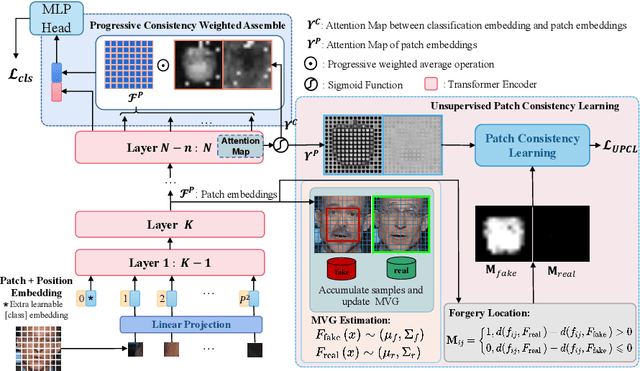


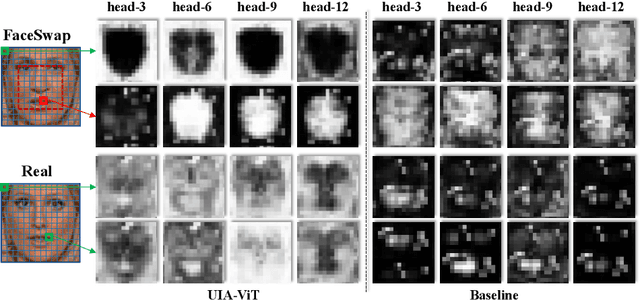
Abstract:Intra-frame inconsistency has been proved to be effective for the generalization of face forgery detection. However, learning to focus on these inconsistency requires extra pixel-level forged location annotations. Acquiring such annotations is non-trivial. Some existing methods generate large-scale synthesized data with location annotations, which is only composed of real images and cannot capture the properties of forgery regions. Others generate forgery location labels by subtracting paired real and fake images, yet such paired data is difficult to collected and the generated label is usually discontinuous. To overcome these limitations, we propose a novel Unsupervised Inconsistency-Aware method based on Vision Transformer, called UIA-ViT, which only makes use of video-level labels and can learn inconsistency-aware feature without pixel-level annotations. Due to the self-attention mechanism, the attention map among patch embeddings naturally represents the consistency relation, making the vision Transformer suitable for the consistency representation learning. Based on vision Transformer, we propose two key components: Unsupervised Patch Consistency Learning (UPCL) and Progressive Consistency Weighted Assemble (PCWA). UPCL is designed for learning the consistency-related representation with progressive optimized pseudo annotations. PCWA enhances the final classification embedding with previous patch embeddings optimized by UPCL to further improve the detection performance. Extensive experiments demonstrate the effectiveness of the proposed method.
 Add to Chrome
Add to Chrome Add to Firefox
Add to Firefox Add to Edge
Add to Edge